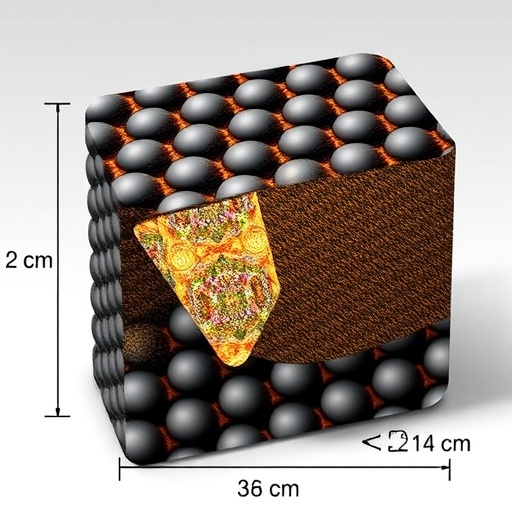In the evolving landscape of material science, graphite has long held a celebrated place, revered for its unique electronic properties and versatility in applications. Recent research, however, has turned the spotlight on graphene oxide, a derivative of graphite that has seen growth in the fields of electronics, energy storage, and sensors. The study conducted by Elhaes and Ibrahim offers groundbreaking insights into the electronic properties of graphene oxide that has been functionalized with benzoic acid.
Graphene oxide is composed of a single atomic layer of carbon atoms arranged in a hexagonal lattice with various oxygen-containing groups. This structural composition presents a unique opportunity for chemical modifications that can enhance its properties further. The functionalization of graphene oxide with organic compounds such as benzoic acid serves a dual purpose; it not only improves the material’s electronic characteristics but also paves the way for its integration into diverse technological applications, thereby expanding its utility.
In this pivotal study, the authors employed advanced characterization techniques to explore the changes in electronic properties that result from benzoic acid functionalization. One of the critical techniques utilized was X-ray photoelectron spectroscopy (XPS), which allows for the analysis of the elemental composition and chemical states of materials at the atomic level. This meticulous approach ensures that the functionalization process is not only successful but also that the resultant chemical bonds are stable and conducive to desired electronic behavior.
Among the intriguing findings of this research was the observation that the functionalization of graphene oxide with benzoic acid significantly altered its conductivity. In its unmodified form, graphene oxide displays semiconducting behavior due to the presence of oxide groups that impede electron flow. However, with the introduction of benzoic acid, researchers noted a remarkable enhancement in conductivity. These changes suggest the possibility of tailoring the electronic properties of graphene oxide for specific applications, such as in sensors where fast electronic responses are paramount.
A pivotal aspect of the study was the utilization of density functional theory (DFT) to computationally model the electronic structure of both unmodified and benzoic acid-functionalized graphene oxide. This theoretical framework allowed for a comprehensive understanding of the band structure and the mechanisms driving which functionalization affects conductivity. The DFT simulations corroborated the experimental findings, revealing a significant narrowing of the energy gap in the functionalized material, which translates to improved electronic transport.
The implications of such enhancements in conductivity are vast. One promising application is in the field of energy storage, particularly in the development of supercapacitors where rapid charging and discharging cycles are essential. The functionalized graphene oxide could serve as an efficient electrode material, capable of storing and delivering energy more effectively than its unmodified counterpart. Such advancements could lead to the next generation of energy devices, making renewable energy more viable and accessible.
In addition to energy storage applications, the study opens doors for advancements in biosensor technology. Graphene oxide’s functionalization with benzoic acid enhances its interaction with biological molecules, thereby increasing its sensitivity and selectivity in detecting biomolecules. This feature could revolutionize the diagnosis of diseases, enabling rapid and precise detection methods that are crucial for timely healthcare interventions.
Another significant aspect of this study is the environmental implications. As the world grapples with sustainability challenges, materials that can be derived from carbon sources and modified for enhanced functionality offer a viable solution. The ability to couple graphene oxide with organic functional groups like benzoic acid signifies a step towards more sustainable materials that can be integrated into various industries without relying heavily on non-renewable resources.
Furthermore, this research aligns with the growing trend towards developing multifunctional materials which can serve multiple purposes. For instance, the combination of unique electronic properties with favorable chemical reactivity could see graphene oxide functionalized with benzoic acid utilized in catalysis, enhancing chemical reactions and processes. This multipurpose utility makes such materials highly desirable in both academia and industry.
This study further emphasizes collaborative efforts within the scientific community. The interlinking of theoretical and experimental approaches enriches the understanding of materials science, leading to significant breakthroughs. The combination of insights gleaned from computational modeling and real-world applications underscores the importance of a multidisciplinary approach in solving complex scientific challenges.
As the researchers elaborated on their findings, the potential for future research directions became evident. Exploring different functionalizing agents, particularly those with diverse electronic and steric properties, could yield a new class of materials with tunable characteristics. This means that the landscape of graphene oxide functionalization is just beginning to unfold, with unlimited possibilities ahead.
Both Elhaes and Ibrahim have set the stage for future inquiries into functionalized graphene materials, with their work serving as a foundation upon which further studies could build. By constantly innovating and expanding upon these initial findings, researchers can continue to push the boundaries of what is possible with graphene oxide and beyond.
In conclusion, the research conducted on graphene oxide functionalized with benzoic acid is a testament to the power of modern materials science. It not only sheds light on the improved electronic properties stemming from chemical modifications but also indicates a myriad of practical applications that could follow. This cross-disciplinary work exemplifies how innovation in material science can create pathways toward achieving both technological advancement and sustainability goals.
As we deepen our understanding of materials like functionalized graphene oxide, we continue to harness their potential for a myriad of applications, from energy to health. The future is undoubtedly bright for materials scientists dedicated to unlocking the secrets of graphene and its derivatives.
Subject of Research: Electronic properties of graphene oxide functionalized with benzoic acid.
Article Title: Investigating the electronic properties of graphene oxide functionalized with benzoic acid.
Article References:
Elhaes, H., Ibrahim, M.A. Investigating the electronic properties of graphene oxide functionalized with benzoic acid. Sci Rep 15, 38105 (2025). https://doi.org/10.1038/s41598-025-22839-w
Image Credits: AI Generated
DOI:
Keywords: Graphene oxide, Benzoic acid, Electronic properties, Functionalization, Conductivity, Density functional theory, Energy storage, Biosensors, Sustainability.




